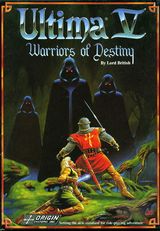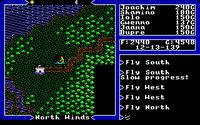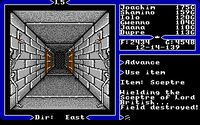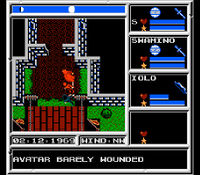Ultima V: Warriors of Destiny
Ultima V: Warriors of Destiny is the fifth game in the series and the second installment of the "Age of Enlightenment" trilogy. It was published and released in 1988 by Origin initially for the Apple II, C64 and IBM PC. Ports for the Amiga and Atari ST followed in 1989 and 1990, respectively, as well as an FM Towns-port. Also in 1990, Pony Canyon released ports for the X68000 and PC-9801, with a final port for the NES in 1993 by FCI.
Gameplay[edit]
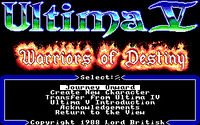
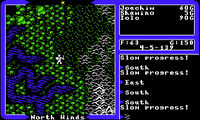
The game was a considerable leap forward from Ultima IV and marked the beginning of complex storytelling in the series. The land of Britannia grew larger in scope with the addition of many new locations, important items and a sprawling subterranean underworld in supplement to the already established dungeons. Also featured was a complete day/night cycle with all world inhabitants following a schedule to match, while dialogue reached new levels of depth to progress a grim, multi-faceted story. The soundtrack maintained the benchmark set by earlier titles while visuals advanced noticeably in color and complexity – particularly dwellings, cities and castles were now more robustly detailed with furnishings and other incidental items, while dungeons became far more vivid in presentation.
The main theme of the game deals clearly with fundamentalism and moral absolutism (turning Virtue into law).
This game marks the first time the runic alphabet is extensively used, forcing the player to frequently self-translate signs, decrees, etc.
The game also provides a feature to transfer the character from the previous game to make the start easier. This is offered on all versions of the game except those on the Amiga and Atari ST, for whatever reasons.
The Story[edit]
Spoiler warning: Plot and/or ending details follow.
Britannia had enjoyed peace and prosperity since the Quest of the Avatar found its champion. The dungeons were soon sealed by the Great Council in the intervening years, with the Eight Virtues strong and the people living in content. However, the existence of a vast and mysterious Underworld was discovered, prompting Lord British himself to set out on a pioneering expedition to thoroughly explore its depths. Not one week into the journey, the king and most of his entourage fell prey to ominous forces and were overwhelmed, leaving British missing. The following appearance of the sinister Shadowlords deeply corrupted the mind of Britannia's interim presiding regent, Lord Blackthorn. With Lord British's fate unknown, a dark tyranny of draconian, extremist "Virtues" ensued, with the Companions of the Avatar declared outlaws.
The player, as the Avatar, returned to Britannia to find it in such peril; governed by a ruthless, dictatorial regime and terrorized by the dark Shadowlords. Gathering as many former companions as possible, the Avatar discreetly sought out guidance in the effort to vanquish the Shadowlords, recovering the Crown Jewels of Lord British and undermining the Oppression – Lord Blackthorn's own agents – in the affair. With the aid of the Codex of Ultimate Wisdom, the Avatar learned the nature of Lord British's imprisonment.
After successfully trapping and destroying each of the Shadowlords, the Avatar descended into the colossal Underworld and the foul dungeon Doom, successfully recovering the captive Lord British and restoring him to the throne. With the Shadowlords' hold over Blackthorn severed, his mind was finally clear but burdened with the knowledge of what had transpired under his rule. Faced with a choice by Lord British to either stand trial before the Great Council or be exiled to a fate unknown, Blackthorn chose the latter, stepping without a word through a waiting red moongate.
Spoilers end here.
Development[edit]
This is the last Ultima to use flat-perspective tile graphics and 3D-dungeons (not counting the Underworlds), and also the last game where the Apple II was the primary development platform.
Differences between platforms[edit]
- Main article: Computer ports of Ultima V
The 8-bit version for the Apple II and C64 are quite different from each other. The Apple II version lacks many of the details and colors of the C64-port, but features full music. The C64-port boasts superior graphics but lacks music, which only can be heard in the C128 variant of the port. This problem is addressed in the fan-optimization Ultima V Remastered.
The 16-bit-ports for the Amiga, Atari ST and IBM PC differ more subtly. Graphically, they appear mostly identical (Amiga and Atari ST versions feature an Ultima V logo permanently emblazoned on the screen). The PC-port, however, lacks any music and mouse support. The Atari ST-port has full music, albeit differing in presentation, and mouse support. The Amiga-port features mouse support but only ever plays the lone piece of music written specifically for it.
There were also several ports of Ultima V for Japanese console systems. They featured superior graphics and sound compared to the North American release. The FM Towns release of Ultima V even came with a full-colour poster not found with other releases of the game.
The NES port of 1993 is a dubious standout. Visually, it resembles Ultima VI but features very little music. The graphics are of lower quality and the game is extremely slow to the point of being almost unplayable, only marred further by a truncated plot. For further reading, see NES-port of Ultima V.
Release[edit]
Ultima V was released to financial and critical success and remains, to many, a superior entry in the series.
The game was included in several compilations:
- Ultima Value Pak (1990) in its original game box.
- Ultima Trilogy IV V VI (1992)
- Ultima I-VI Series (1993)
- Ultima Collection (1998)
In Japan, the game got included in the compilation Ultima Complete.
Distribution of the game in Europe was first done by MicroProse, but later on Mindscape took over those duties.
Included with the game[edit]
The release of Ultima V included:
- The Book of Lore
- A cloth map of Britannia
- A Codex Coin (as seen in the introduction sequence)
- The Journal of Lord British's Journey to the Underworld, a precursory log detailing the king's disappearance
- Ultima V Quick Reference Card
- The Player Reference Card
Upgrades[edit]
Upgrade Patch[edit]
A fan-made Ultima V upgrade patch re-inserts all musical pieces from other versions of the game to the IBM PC version.
Ultima V: Lazarus[edit]
Ultima V: Lazarus is a comprehensive remake of the game using the Dungeon Siege engine. See the Lazarus project for more information.
Neat Ultima V[edit]
There has also been an attempt to port Ultima V to MS-Windows. Neat Ultima V is a project similar to xu4 or the more ambitious Exult to create a new game engine utilizing the original data files. Unfortunately, development has been abandoned.
Ultima V: Warriors of Destiny for TI Calculators[edit]
A complete and faithful remake for TI-89, TI-92+, and TI-V200 calculators. See Ultima V project forum for more information.
More Game Related Information[edit]
- NPCs
- Spells
- Bugs
- Cheating in Ultima V
- Ultima V Real-life references and Easter eggs
- Ultima V internal formats
- Party members in Ultima V
- Ultima V walkthrough
- Ultima V transcript
- Ultimatrix – map viewer
- Ultima Saved Game Editor
- For how the character creation works, see Character creation
Trivia[edit]
- This is the first Ultima game with NPC schedules and day-night cycles.
- First traditional hint-giving appearance of Smith the Horse.
- A completion certificate could originally be obtained after winning the game.
- For promotion, Origin Systems had an Ultima V t-shirt in their catalogue.
- The flame animation that appears on the Apple II version's title screen was subsequently reused by industry veteran and former Origin programmer John Romero, of Wolfenstein 3D and Doom renown, in the PC-port of his 1988 platform game, Dangerous Dave.[1]
Gallery[edit]
See Also[edit]
External Links[edit]
- Ultima V: Warriors of Destiny (Wikipedia)
- Notable Ultima – a site dedicated to various Ultima games
- Ultima V: Warriors of Destiny – The Other Codex
- Ultima 5 Upgrade – a patch to upgrade Ultima V
- Ultima V: Warriors of Destiny nitpicks
- Ultima 5 – at Ultima Aiera
- Ultima V: Warriors of Destiny – for TI Calculators
- Neat Ultima V – an abandoned project
- Ultima V: Lazarus – a fan project
- Ultima V – Warriors of Destiny – at the C64 Wiki
References[edit]
- ↑ Romero, John. “John Romero on Twitter”. Twitter. 2014-11-11. Retrieved 2016-08-18.
